|
-
13th August 25, 01:59 PM
#1
Sorry, but I don't have any direct experience with real PV or Atlanta kilts.
I have Pakistani kilts made from whatever they use. I've heard real PV is better/different than acrylic. But Atlanta says theirs is acrylic. This is the first place I've seen acrylic in a weight claiming to be 16 oz though. That would seem far heavier than anything I've experience. Not sure how it would work either. Even if its as thick as 16 oz wool, its a far lighter material. So is it supposed to be thick enough to actually weigh that much ?
Perusing their web site, I could not tell what was different about their tartan hybrid kilt. Its even the same price as traditional. And you could get pockets on the "traditional". Plus, the 1st picture of it shows a kilt that's WAY too long.
Have you thought about denim, or canvas-like material used more for utility kilts ? One of my pakistani kilts is denim, and its my go-to anytime I'm working in it - yard work or cooking. Its perfect for that - just get dirty, machine wash it, and its ready for next time (except for the ironing 
Its not as heavy as my wool kilts, and doesn't need expensive dry cleaning. I just wouldn't put a nice, expensive kilt through that kind of duty anyway.
-
-
13th August 25, 02:40 PM
#2
To be honest, I'd stick with wool. Perhaps something less than 16 oz and perhaps less than a "9 yard" I think long term, you'd be better off.
Rev'd Father Bill White: Mostly retired Parish Priest & former Elementary Headmaster. Lover of God, dogs, most people, joy, tradition, humour & clarity. Legion Padre, theologian, teacher, philosopher, linguist, encourager of hearts & souls & a firm believer in dignity, decency, & duty. A proud Canadian Sinclair with solid Welsh and other heritage.
-
The Following User Says 'Aye' to Father Bill For This Useful Post:
-
13th August 25, 02:48 PM
#3
P
If you are intending to wear your intended kilt in a formal or other smart scenario I would suggest a 13oz wool may be suitable for the Florida climate.
Wool kilts tend to last years and keep their shape well.
Janner52
Exemplo Ducemus
-
The Following User Says 'Aye' to Janner52 For This Useful Post:
-
13th August 25, 04:28 PM
#4
Perhaps the best alternative to wool is true P/V. Now, to get things straight, there are a lot of kilts out there sold as P/V that are not actually a blend of Polyester and Viscose (Rayon in N. America)
To my knowledge there is only one mill weaving true P/V and that is Marton Mills in Otley, England. The fabric they sell is a blend of 60% Polyester and 40% Rayon. If a kilt maker is advertising that their product is made from P/V ask which mill wove the fabric. If they do not say Marton Mills, pass them by.
There are very few makers using Marton Mills P/V. USA Kilts is perhaps the best known and most respected. I would give their Casual model, their Semi-Trad model, their 5 yard model, or their Box Pleated model a good look.
The highlights of what to look for when choosing a kilt that can be worn for dressy occasions are -
The Tartan pattern is aligned perfectly everywhere. This includes not only in the back where the pleats are sewn but at the upper band in the front.
This is unprofessional.

The pleats should hang vertically in the back. The kilt should not look like an "A" line skirt.
This looks bad.

The Tartan pattern in the Pleats should be consistent and even all the way down the pleat. You should not see the Tartan pattern wavy, crooked, or closer to one edge as you look down the pleat.
Avoid this.
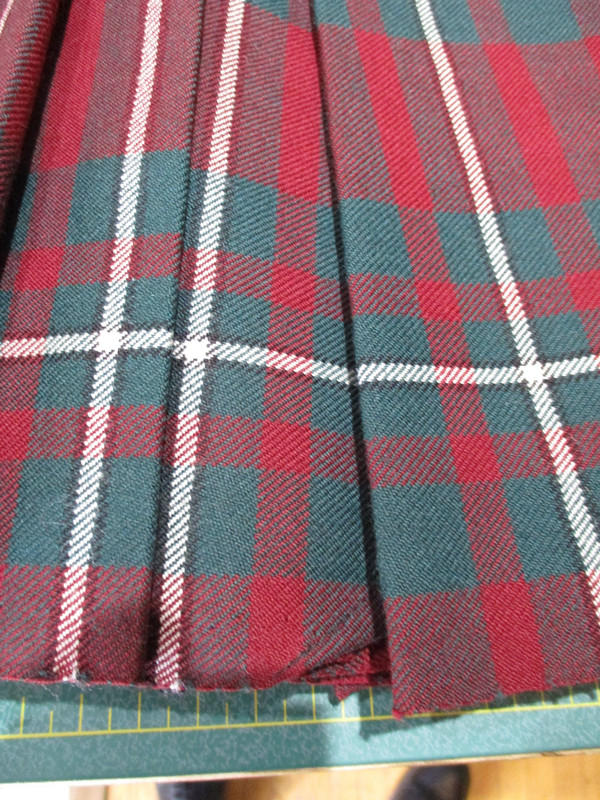
The pleats should hang in the back without any waves, or wrinkles. From just a few feet away it should not look like there are any pleats at all.
Run Away, Run Away!

If there are loops on the back of the kilt, they are not belt loops. They are to hold the sporran strap, not hold the kilt up.
Only if you do not care that your kilt will be distorted out of shape very quickly.
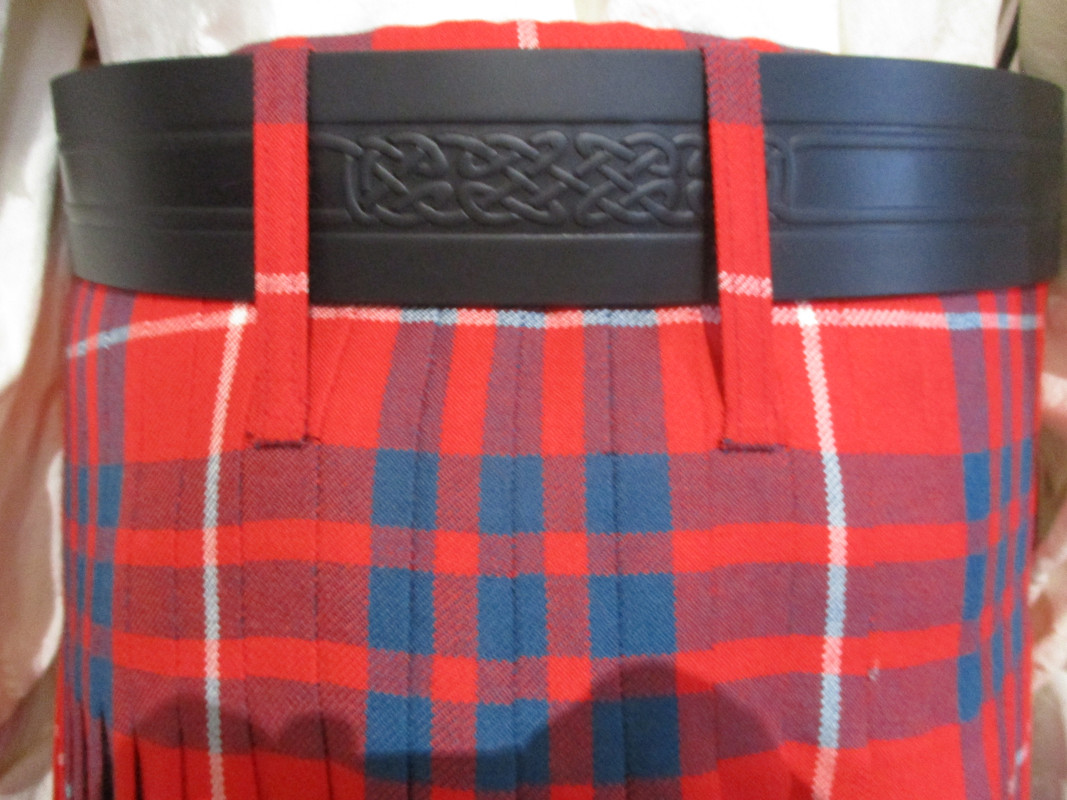
Remember that a kilt is not worn like a pair of trousers. The top of the kilt is worn high. And the bottom should show some knee.
If you wear a vest there should be no shirt showing.

More than any other thing that tells a good kilt from a kilt that is not so good is -
If you grab the buckles in the back and pull, you should not see any stretching, which puts stress on the pleat stitching. The stitching will fail.
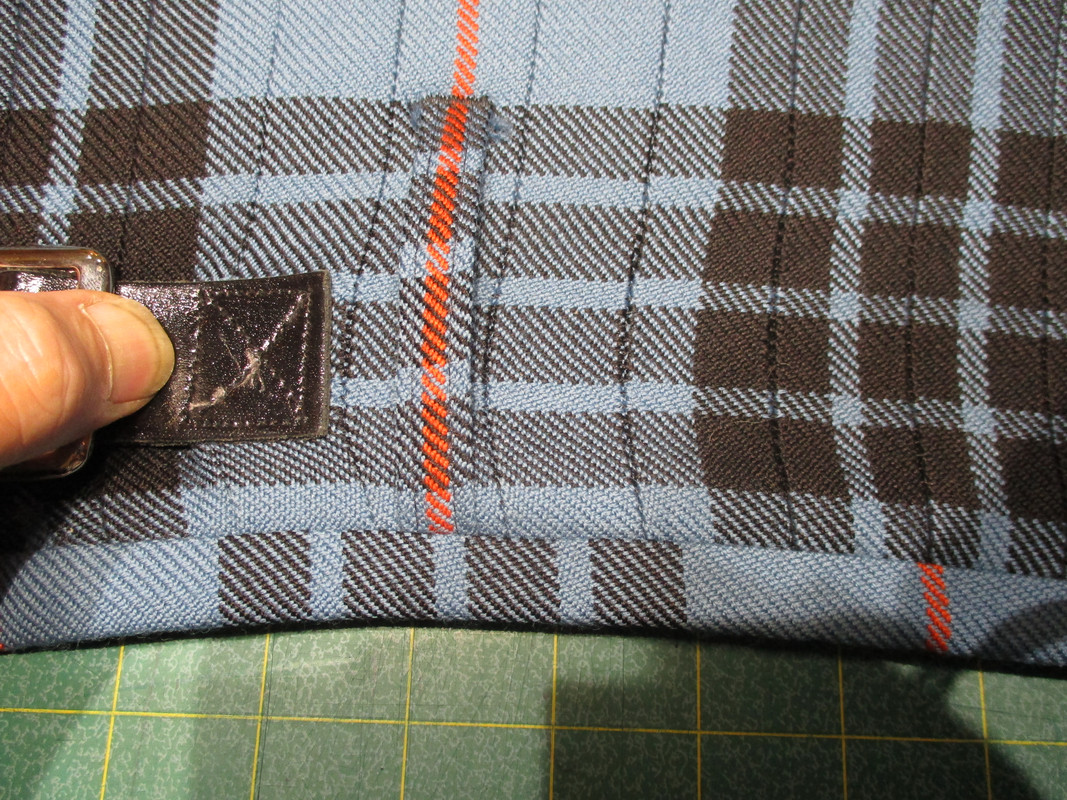
This is due to the internal construction. The liner inside the kilt is not to keep the kilt clean. If that were true the liner would be removable and washable. The liner is there only to hide the internal strengthening elements built inside.
If you can lift the liner and see nothing underneath, the kilt will fall apart after just a few wearings.
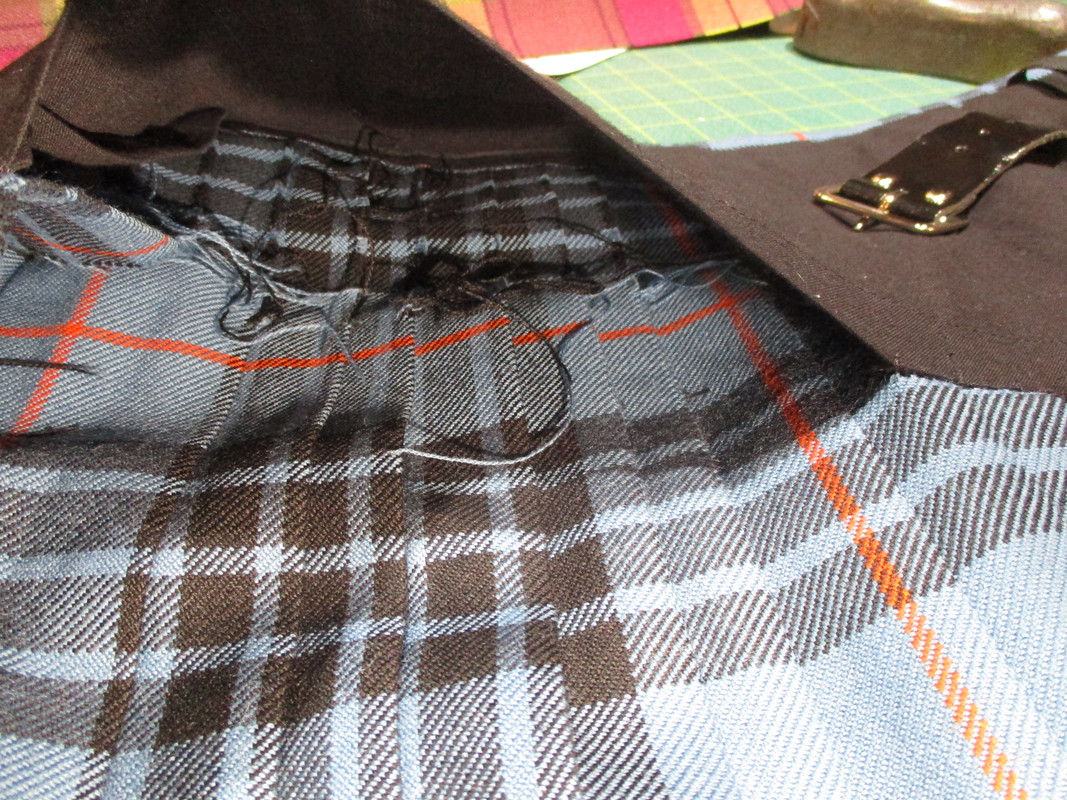
While it is true that nothing looks, hangs, or swishes, like a full Hand-stitched wool kilt made by a custom kiltmaker, it is how the kilt is made, far more than the fabric it is made from, that makes the difference in the lok, and your enjoyment of, your kilt. Here is an example of a 16oz wool kilt flanked by two true P/V kilts.
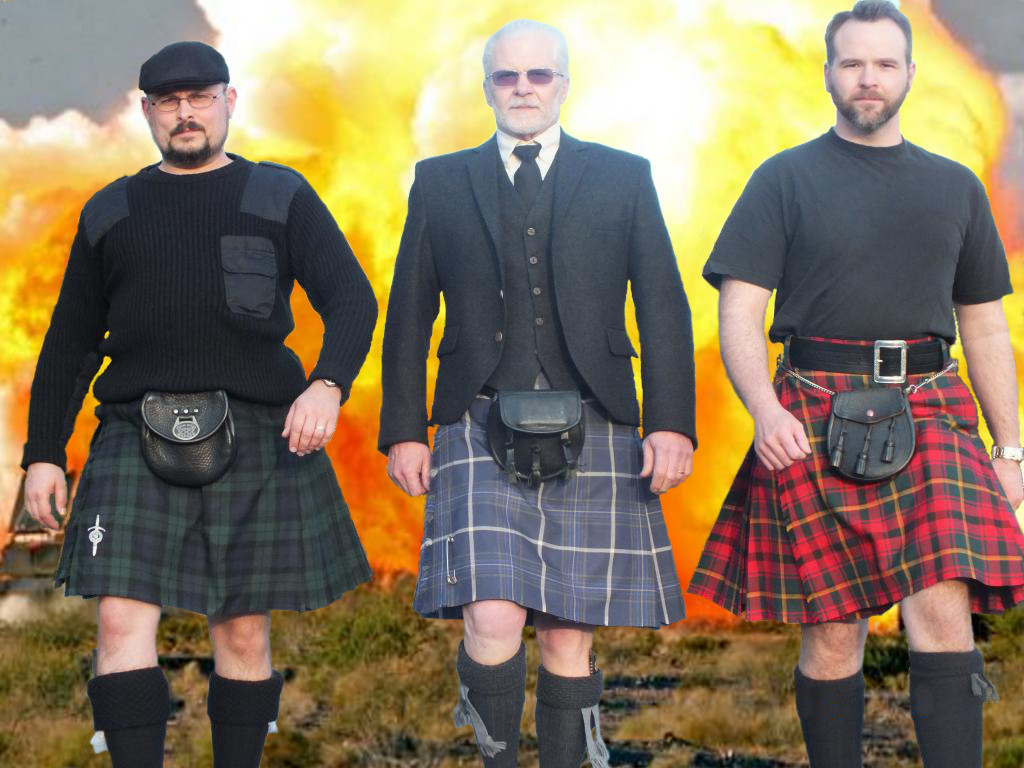
Oh -- and an edit on fabric weights.
When a seller says an 8 yard kilt, they are talking about the length of the fabric not the width.
Fabric is sold by the length also, but the width is different.
Fabric is sold by the yard at 60 inches in width. This means that one fabric yard is 36 inches X 60 inches.
An 8 yard kilt 24 inches long uses only 40% of 8 fabric yards.
An 8 yard kilt of 16oz fabric will weigh around 50-52 ounces. Or about 3.25 pounds.
True Marton Mills P/V fabric weighs just under 12oz per fabric yard. This means that an 8 yard P/V kilt should weigh about 25.5 oz or between 1.6 and 1.75 pounds.
Most of the Acrylic kilts I have run across weigh about 4-5 oz per fabric yard. So an Acrylic kilt will come in at about 3/4 of a pound.
A good question to ask a kilt seller, is how much does their 8 yard kilt weigh.
Last edited by Steve Ashton; 13th August 25 at 09:24 PM.
-
The Following 7 Users say 'Aye' to Steve Ashton For This Useful Post:
-
16th August 25, 06:23 PM
#5
 Originally Posted by Steve Ashton

...one mill weaving true P/V and that is Marton Mills...
If a kilt maker is advertising that their product is made from P/V ask which mill wove the fabric. If they do not say Marton Mills, pass them by.
Steve is bang on, this is the crux of the matter.
AFAIK Marton Mills is the only acceptable alternative to the traditional wool.
Personally, all my kilts are traditional wool kilting cloth.
I always go for 16 ounce because it looks better, feels better, holds pleats better, everything.
I have one 13 ounce kilt (which I had to order due to the pipe band I was playing in at the time).
After wearing 16 ounce kilts repeatedly over months, when I put on that 13 ounce kilt it feels insubstantial and flimsy.
That's just the feeling! It looks perfectly fine, in truth. But I'd never go with anything lighter than that.
(My 13 ounce kilt.)

Last edited by OC Richard; 16th August 25 at 06:26 PM.
Proud Mountaineer from the Highlands of West Virginia; son of the Revolution and Civil War; first Europeans on the Guyandotte
-
-
16th August 25, 09:17 PM
#6
For your first kilt, if you're not sure how much you'll be wearing it and want something less expensive, sharp looking, cool for hot weather, and durable for festivals and work, I recommend getting a casual kilt in PV from USAKilts.
They're not quite traditional, but they're pretty close. I've looked at cheaper kilts, and in my opinion, paying the extra for a USAKilts casual kilt in PV is absolutely worth it.
If you wear it for a few months and decide you like it, then I'd drop the extra money for a traditional wool kilt.
A lot of people will recommend going straight for a traditional wool kilt. That's fine advice too. But personally, I've spent money on the good stuff only to realize it wasn't my thing too many times. So I prefer a more cautious approach to spending. And if you end up really liking kilts, having one PV and one wool is a good thing.
P.S. Some people swear that wool kilts are good for hot weather if you get a low yardage kilt. I cannot comment on that yet.
-
-
16th August 25, 10:08 PM
#7
 Originally Posted by User

For your first kilt, if you're not sure how much you'll be wearing it and want something less expensive, sharp looking, cool for hot weather, and durable for festivals and work, I recommend getting a casual kilt in PV from USAKilts.
They're not quite traditional, but they're pretty close. I've looked at cheaper kilts, and in my opinion, paying the extra for a USAKilts casual kilt in PV is absolutely worth it.
If you wear it for a few months and decide you like it, then I'd drop the extra money for a traditional wool kilt.
A lot of people will recommend going straight for a traditional wool kilt. That's fine advice too. But personally, I've spent money on the good stuff only to realize it wasn't my thing too many times. So I prefer a more cautious approach to spending. And if you end up really liking kilts, having one PV and one wool is a good thing.
P.S. Some people swear that wool kilts are good for hot weather if you get a low yardage kilt. I cannot comment on that yet.
I would argue in favor of the next step up from USA Kilt, the semi-tradtional PV kilt. I'm not a big velcro fan, so I would rather have the straps of the semi-trad.
-
The Following User Says 'Aye' to geomick For This Useful Post:
-
17th August 25, 11:01 AM
#8

 Originally Posted by Steve Ashton;1412282To my knowledge there is only one mill weaving true P/V and that is Marton Mills in Otley, England. The fabric they sell is a blend of 60% Polyester and 40% Rayon. If a kilt maker is advertising that their product is made from P/V ask which mill wove the fabric. If they do not say Marton Mills, pass them by.
There are very few makers using Marton Mills P/V. USA Kilts is perhaps the best known and most respected. I would give their Casual model, their Semi-Trad model, their 5 yard model, or their Box Pleated model a good look.
While it is true that nothing looks, hangs, or swishes, like a full Hand-stitched wool kilt made by a custom kiltmaker, it is how the kilt is made, far more than the fabric it is made from, that makes the difference in the lok, and your enjoyment of, your kilt. Here is an example of a 16oz wool kilt flanked by two true P/V kilts.
[IMG
https://i.postimg.cc/gcx71jyC/Licensed-To-Kilt.jpg[/IMG]
WOW! GREAT post!
I have two (oops, make that THREE—or maybe even FOUR) questions as a result:
- The photo above suggests that the PV will "buckle" a bit more easily when the wool would probably "sway," is that a fair inference?
- Is there ANY chance you and Barb Tewksbury will resurrect your "how to make a kilt" seminars? My sister and I live thousands of miles apart, but we truly enjoy long visits (including 2 weeks in Scotland summer of 2023), and Barb has made ONE kilt for me. As a consequence, she suffers through possibly too many emails from me as I try to decide what to have made next. I'm pretty certain you'd have 2, or maybe even 3, including my own spouse, attending one of those courses if you ever did it again.
- Why is it that your SO important photo shows up in MY response solely as a URL link?
- What's the provenance of those "shoulder pads" and breast pocket affixed to the sweater of the guy on the left?
And, I LOVED the photo's caption when I resolved the link in my own browser. My license plate says KILTER. My wife often intimates she'll refuse to ride in my car for fear of people (especially now that we live in "Sin City"—where one of the favored attractions is "The Mob Museum"—actually mistaking my purpose in life
-
-
17th August 25, 12:39 PM
#9
 Originally Posted by jsrnephdoc

...
Why is it that your SO important photo shows up in MY response solely as a URL link?
...
[IMG
https://i.postimg.cc/gcx71jyC/Licensed-To-Kilt.jpg[/IMG]
You chopped up the link and added bad formatting to it.
1. Remove the bold effect from [IMG
2. Put back in the closing square brace for the opening IMG tag [IMG]
3. If there's a newline after the opening IMG tag, remove that.
Now it will work. You can use the preview button to make sure you've formatted it correctly before posting.

-
-
Last edited by OC Richard; Yesterday at 02:51 PM.
Proud Mountaineer from the Highlands of West Virginia; son of the Revolution and Civil War; first Europeans on the Guyandotte
-
Tags for this Thread
 Posting Permissions
Posting Permissions
- You may not post new threads
- You may not post replies
- You may not post attachments
- You may not edit your posts
-
Forum Rules
|
|









 Reply With Quote
Reply With Quote

























Bookmarks